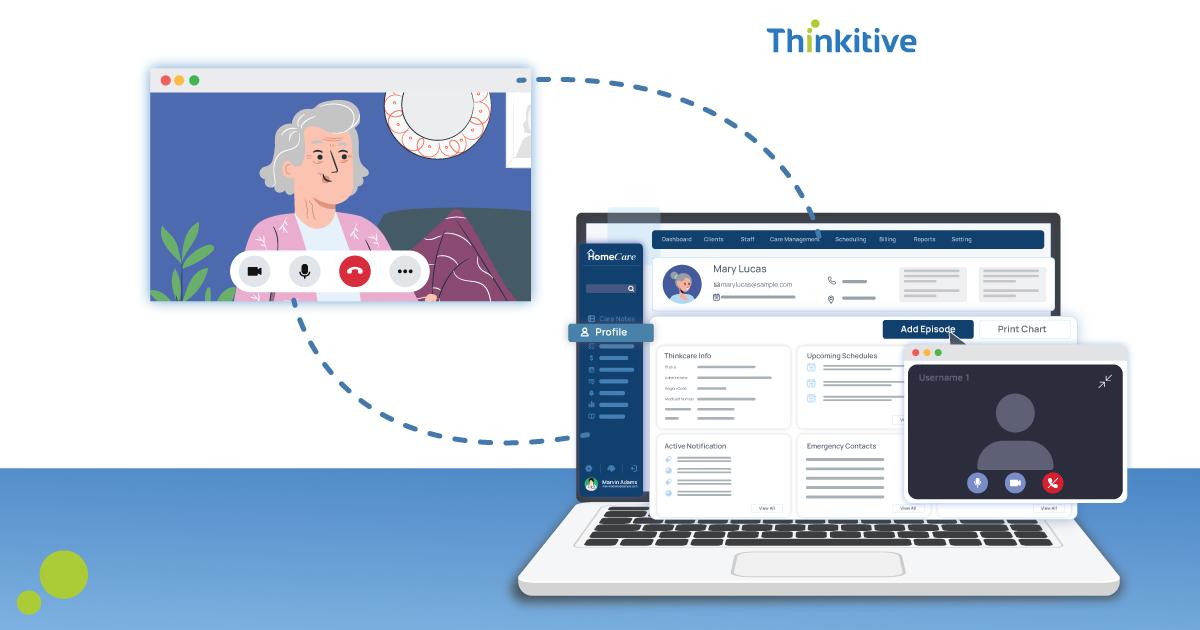There has been a shift in the healthcare industry which is paving the roadmap for healthcare practices as it continues to evolve. As the relevance of digital technologies in healthcare practices is taking the healthcare industry towards a digital transformation, the role of telehealth is believed to be pivotal.
While many practices are embracing it, there are even more patients demanding telehealth services. This trend has given rise to many healthcare institutions to adopt custom healthcare software solutions to enhance their entire care delivery process.
Having said that, the growing relevance of telehealth in healthcare has got healthcare practices to include telehealth in almost every aspect of care. One such practice that is unique in its own nature that is integrating telehealth in their care delivery module is home healthcare services.
Here, you might ask why a home care agency needs telehealth integration in home care software, since there are hardly any interactions virtually and hardly any patient provider consultation?
Well, that has been the impact of telehealth on custom healthcare solutions that even home healthcare agencies are looking to integrate it. As surprising as it is for you, it was for us as well when one of our clients asked us to integrate telehealth into their custom home healthcare software.
Though that is a topic for another case study, in this blog, let’s explore the benefits of integrating telehealth in custom home healthcare solutions and everything you need to know about it.
So, without further ado, let’s get started!
Benefits of Integrating Telehealth into Home Healthcare
Telehealth is used for closing the communication gaps between patients and providers and allowing them to connect virtually. So here is how a home healthcare practice can benefit from integrating telehealth with their custom home healthcare software:
- Improved Patient Access to Care: There are many different types of home healthcare services provided by caregivers. While some are clinical in nature and others are non-clinical, some services require in-person visits, whereas others can be done virtually. In such cases, patients in remote or underserved areas can assess high-quality care, such as emotional support therapies, virtually. Along with that, in the case of a caregiver providing in-person service, the patient can connect with the physician in real time and make modifications to the care services that are being provided almost instantly.
- Reduced Costs: By allowing patients and providers to connect virtually, the major advantage of telehealth is that it reduces costs for both patients and providers. Since it does not require the patient or provider to physically travel to the clinic, unnecessary in-person visits are avoided, allowing the practice to significantly reduce the cost of care service delivery.
- Enhanced Care Quality: Telehealth can improve the quality of care by allowing providers to remotely monitor patients’ health. With the help of RPM devices, monitoring patients’ conditions becomes much easier, and with accurate and real-time data access, faster interventions can be done to improve patient health outcomes.
- Improved Patient Outcomes: Patients who have been using telehealth services have shown reduced hospitalizations and better adherence to medications and treatment plans. These have a direct impact on patient health outcomes, and many studies have proved that telehealth can improve patient health outcomes.
Key Considerations for Integrating Telehealth
While you might be thinking of the lucrative benefits of integrating telehealth with your custom home healthcare software, there are some considerations that you must take into consideration. Here are some that you must consider before making a direct shift:
- Technology Infrastructure: Home healthcare agencies work in a unique way that is quite unorthodox in the care delivery of other healthcare services. That is why ensuring a technology infrastructure to support telehealth services is necessary. Some of the key components of this infrastructure include high-speed internet, secure video conferencing platforms, and its integration with your custom home healthcare mobile application.
- Regulatory Compliance: Since the healthcare landscape is driven by technology, it is necessary to ensure that healthcare practices work in an ethical way and safeguard patient data while maintaining privacy. Some of these compliances include HIPAA and state-specific licensing requirements.
- Patient Privacy and Security: Apart from abiding by the regulatory requirements, you also need to consider patient privacy and security for your telehealth and custom home healthcare platform. Since it will be dealing with sensitive patient data, proper measures need to be taken to prevent unauthorized access to patient data.
- Reimbursement: Last but not least, you need to understand the reimbursement landscape for telehealth with home healthcare services. Since your organizational needs should align with the billing rules and requirements, it can help you get properly reimbursed.
Telehealth Technologies for Home Health Care
Since home healthcare practices are unique, integrating them into your custom home healthcare software will require you to integrate all its supporting technologies to harness its exclusive benefits. Here are the telehealth technologies for home health care that you need to integrate:
- Video Conferencing Platform: The first thing you will need is a video conferencing for home care to conduct real-time telehealth consultations. This platform should be open for all the care members so that both patients and providers can join comfortably. Along with that, it should be a dedicated platform for care delivery, and you should provide stable, secure and HIPAA-compliant telehealth solutions.
- Remote Patient Monitoring: To track patient health vitals in real-time, you need to leverage remote patient monitoring devices, and remote patient monitoring with telehealth platforms. This will enable you to provide care instantly and enhance your care delivery process with more accuracy. Here, along with integrating video conferencing for home care, you also need to establish RPM devices to track patient health vitals and other metrics remotely.
- Mobile Health App: To further bridge the gap between care accessibility, mobile telehealth app development can be a great way. This not only makes it more convenient for the patients, but with a mobile app, you can establish direct and secure telehealth communication with the patient. This way, you can leverage the app to educate patients by providing them educational resources, medication reminders, and other tools that can be used to manage their health.
Developing a Telehealth Strategy
Just integrating your custom home healthcare software with telehealth is not enough. You also need to develop a strategy where you can actually use the secure telehealth communication capabilities of your software. Here are some considerations that you should consider while developing a telehealth strategy:
- Assess Your Needs: First, you need to look for spaces where you can put the telehealth technologies to their best use. Along with that, check where the telehealth actually aligns with the organization’s specific needs and goals.
- Choose the Right Technologies: Selecting the right telehealth technologies is also something that you need to consider when looking to integrate telehealth technologies. These technologies should perfectly align with your practice’s needs and fit in your budget as well.
- Develop a Plan: Create a detailed plan about implementing telehealth services with requests to your home healthcare software’s unique workflow. This will allow you to harness its maximum benefits.
- Provide Training and Support: Train your staff on effectively using telehealth technologies and discuss the terms for providing ongoing support while using the software. This will allow your staff members to use the software to its full potential and harness its benefits exclusively.
Conclusion
Telehealth integration in home care software can revolutionize your practice and further close the accessibility and connectivity gaps in care. On top of that, by integrating with a cloud-based telehealth platform it might give you enough flexibility and scalability options to explore other care delivery options and expand your practice.
On that note, help us help you in integrating telehealth with your custom home healthcare software and enhance your healthcare offerings with a wide range of offerings.

